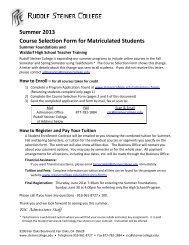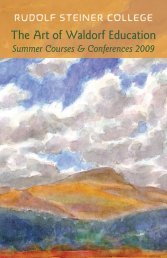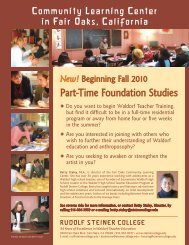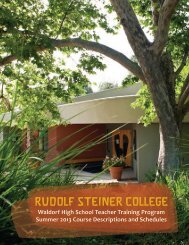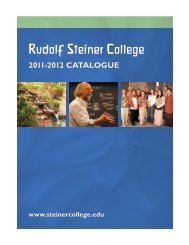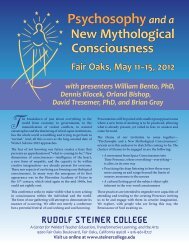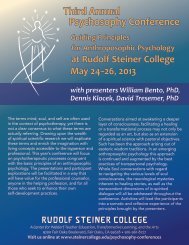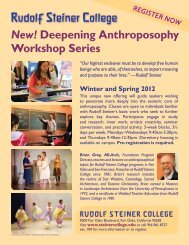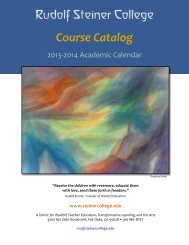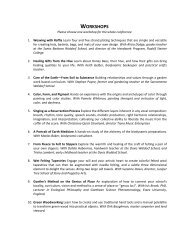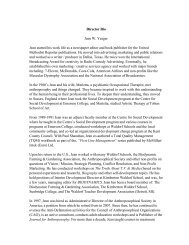Student Handbook - Rudolf Steiner College
Student Handbook - Rudolf Steiner College
Student Handbook - Rudolf Steiner College
Create successful ePaper yourself
Turn your PDF publications into a flip-book with our unique Google optimized e-Paper software.
<strong>Rudolf</strong> <strong>Steiner</strong> and Anthroposophy<br />
Dr. <strong>Rudolf</strong> <strong>Steiner</strong> (1861–1925), a native of Austria, was a scientist and philosopher and a researcher into<br />
the nature of the human being and of the world. He wrote over forty books and gave about 6,000 lectures,<br />
most of which have been transcribed and published in book form. His collected works comprise over<br />
350 volumes and cover almost every area of human inquiry and activity, including philosophy, religion,<br />
history, natural science, mathematics, medicine, education, the arts, architecture, economics, and social<br />
organization.<br />
<strong>Steiner</strong>’s worldview, which he called Anthroposophy (“true knowledge of the human being”), is based<br />
on an understanding of the human as ultimately a spiritual being. He held that modern life must be<br />
transformed on the basis of this understanding. From <strong>Steiner</strong>’s indications in various fields, practical and<br />
artistic applications of Anthroposophy (also called “Spiritual Science”) have been developed. These include<br />
biodynamic agriculture, anthroposophically extended medicine, an approach to working with people with<br />
developmental challenges, Waldorf Education, the Threefold social order, and organic architecture.<br />
The General Anthroposophical Society, based in Dornach, Switzerland (near Basel), is founded on <strong>Rudolf</strong><br />
<strong>Steiner</strong>’s teachings and work. The Society has about 50,000 members around the world, of whom about<br />
4,500 are members of the Anthroposophical Society in America.<br />
Roots and History of <strong>Rudolf</strong> <strong>Steiner</strong> <strong>College</strong><br />
<strong>Rudolf</strong> <strong>Steiner</strong> <strong>College</strong> was founded in 1976, but the beginnings of anthroposophical activity in Sacramento<br />
go back to the early 1940s. Lysbeth “Betty” Buck (1913–1987), a California native, came to know about<br />
Anthroposophy in England in the late 1930s and organized some activities when she returned to her<br />
home state. In 1959, she helped found the Sacramento Waldorf School. Four years later, Betty Buck was<br />
instrumental in forming the Faust Branch, the local branch of the Anthroposophical Society in America.<br />
A group of local people meeting with Carl and Christine Stegmann were inspired to create the <strong>College</strong><br />
on February 22, 1976. It was first called the Sacramento Center for Anthroposophical Studies and its<br />
initial focus was the spiritual destiny of America. Carl then invited René and Merlyn Querido to join the<br />
endeavor. After their arrival in 1977, emphasis was placed on establishing a Foundation Year program to<br />
introduce students to the insights of Anthroposophy and a Teacher Training program to train teachers for<br />
the Waldorf schools. The center’s name was changed to <strong>Rudolf</strong> <strong>Steiner</strong> <strong>College</strong> in 1979. Betty Staley and<br />
Nancy Poer, who were among the <strong>College</strong>’s founders, have continued the work on the spiritual destiny of<br />
America at the <strong>College</strong> for over thirty years.<br />
2



